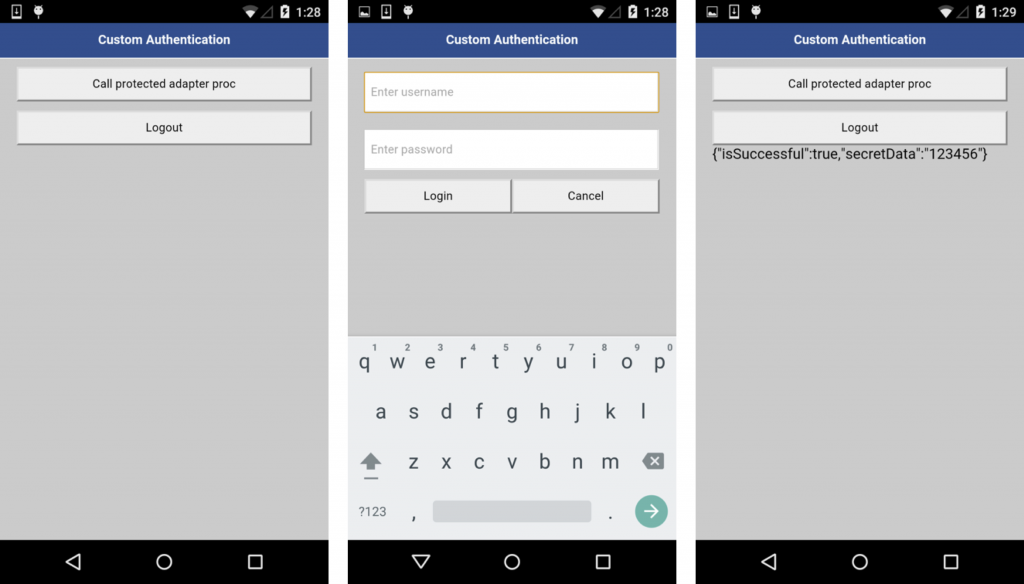Custom Authentication in hybrid applications
improve this page | report issueOverview
This is a continuation of Custom Authentication.Creating client-side authentication components
The application consists of two main div elements:
The AppDiv element is used to display the application content.
The AuthDiv element is used for authentication forms.
When authentication is required, the application hides AppDiv and shows AuthDiv. When authentication is complete, it does the opposite.
AppDiv
<div id="AppDiv">
<input type="button" id="getSecretDataButton" value="Call protected adapter proc" onclick="getSecretData()" />
<input type="button" class="appButton" value="Logout" onclick="WL.Client.logout('CustomAuthenticatorRealm',{onSuccess: WL.Client.reloadApp})" />
<div id="ResponseDiv"></div>
</div>
Buttons are used to call the getSecretData procedure and to log out.
AuthDiv
<div id="AuthDiv" style="display: none"
<p id="AuthInfo"></p>
<div id="loginForm">
<input type="text" id="AuthUsername" placeholder="Enter username" />
<br/>
<br/>
<input type="password" id="AuthPassword" placeholder="Enter password" />
<br/>
<input type="button" id="AuthSubmitButton" class="formButton" value="Login" />
<input type="button" id="AuthCancelButton" class="formButton" value="Cancel" />
</div>
</div>
AuthDiv is styled with display:none because it must not be displayed before the server requests the authentication.
Challenge Handler
Use WL.Client.createChallengeHandler to create a challenge handler object. Supply a realm name as a parameter.
var customAuthenticatorRealmChallengeHandler = WL.Client.createChallengeHandler("CustomAuthenticatorRealm");
The isCustomResponse function of the challenge handler is called each time a response is received from the server.
It is used to detect whether the response contains data that is related to this challenge handler. It must return true or false.
customAuthenticatorRealmChallengeHandler.isCustomResponse = function(response) {}
If isCustomResponse returns true, the framework calls the handleChallenge function. This function is used to perform required actions, such as hide application screen and show login screen.
customAuthenticatorRealmChallengeHandler.handleChallenge = function(response){}
In addition to the methods that the developer must implement, the challenge handler contains functionality that the developer might want to use:
- submitLoginForm to send collected credentials to a specific URL. The developer can also specify request parameters, headers, and callback.
- submitSuccess to notify the framework that the authentication finished successfully. The framework then automatically issues the original request that triggered the authentication.
- submitFailure to notify the framework that the authentication completed with a failure. The framework then disposes of the original request that triggered the authentication
Note: Attach each of these functions to its object. For example: myChallengeHandler.submitSucces()
isCustomResponse
If the challenge JSON block contains the authStatus property, return true, otherwise return false.
customAuthenticatorRealmChallengeHandler.isCustomResponse = function(response) {
if (!response || !response.responseJSON) {
return false;
}
if (response.responseJSON.authStatus)
return true;
else
return false;
};
handleChallenge
If the authStatus property equals “required”, show the login form, clean up the password input field, and display the error message if applicable.
if authStatus equals “complete”, hide the login screen, return to the application, and notify the framework that authentication completed successfully.
customAuthenticatorRealmChallengeHandler.handleChallenge = function(response){
var authStatus = response.responseJSON.authStatus;
if (authStatus == "required"){
$('#AppDiv').hide();
$('#AuthDiv').show();
$("#AuthInfo").empty();
$('#AuthPassword').val('');
if (response.responseJSON.errorMessage){
$("#AuthInfo").html(response.responseJSON.errorMessage);
}
} else if (authStatus == "complete"){
$('#AppDiv').show();
$('#AuthDiv').hide();
customAuthenticatorRealmChallengeHandler.submitSuccess();
}
};
Clicking the login button triggers the function that collects the user name and password from HTML input fields and submits them to server. You can set request headers here and specify callback functions.
$('#AuthSubmitButton').bind('click', function () {
var reqURL = '/my_custom_auth_request_url';
var options = {};
options.parameters = {
username : $('#AuthUsername').val(),
password : $('#AuthPassword').val()
};
options.headers = {};
customAuthenticatorRealmChallengeHandler.submitLoginForm(reqURL, options, customAuthenticatorRealmChallengeHandler.submitLoginFormCallback);<br />
});
Clicking the cancel button hides AuthDiv, shows AppDiv and notifies the framework that authentication failed.
$('#AuthCancelButton').bind('click', function () {
$('#AppDiv').show();
$('#AuthDiv').hide();
customAuthenticatorRealmChallengeHandler.submitFailure();
});
The submitLoginFormCallback function checks the response for the containing server challenge once again. If the challenge is found, the handleChallenge function is called again.
customAuthenticatorRealmChallengeHandler.submitLoginFormCallback = function(response) {
var isLoginFormResponse = customAuthenticatorRealmChallengeHandler.isCustomResponse(response);
if (isLoginFormResponse){
customAuthenticatorRealmChallengeHandler.handleChallenge(response);
}
};
Worklight Protocol
If your custom authenticator uses WorklightProtocolAuthenticator, some simplifications can be made:
- Create the challenge handler using
WL.Client.createWLChallengeHandlerinstead ofWL.Client.createChallengeHandler. Note theWLin the middle. - You no longer need to implement
isCustomResponseas the challenge handler will automatically check that the realm name matches. handleChallengewill receive the challenge as a parameter, not the entire response object.- Instead of
submitLoginForm, usesubmitChallengeAnswerto send your challenge response as a JSON. - There is no need to call
submitSuccessorsubmitFailureas the framework will do it for you.
For an example that uses
WorklightProtocolAuthenticator, see the Remember Me tutorial or this video blog post.
Sample application
Click to download the MobileFirst project.

Inclusive terminology note: The Mobile First Platform team is making changes to support the IBM® initiative to replace racially biased and other discriminatory language in our code and content with more inclusive language. While IBM values the use of inclusive language, terms that are outside of IBM's direct influence are sometimes required for the sake of maintaining user understanding. As other industry leaders join IBM in embracing the use of inclusive language, IBM will continue to update the documentation to reflect those changes.